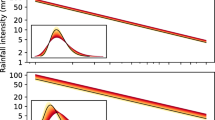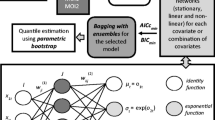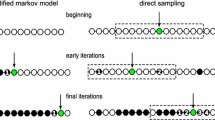Abstract
An original approach is proposed to estimate the impacts of climate change on extreme events using an hourly rainfall stochastic generator. The considered generator relies on three parameters. These parameters are estimated by average, not by extreme, values of daily climatic characteristics. Since climate changes should result in parameters instability in time, the paper focuses on testing the presence of linear trends in the generator parameters. Maximum likelihood tests are used under a Poisson–Pareto-Peak-Over-Threshold model. A general regionalization procedure is also proposed which offers the possibility to work on both local and regional scales. From the daily information of 139 rain gauge stations between 1960 and 2003, changes in heavy precipitations in France and their impacts on quantile predictions are investigated. It appears that significant changes occur mainly between December and May for the rainfall occurrence which increased during the four last decades, except in the Mediterranean area. Using the trend estimates, one can deduced that these changes, up to now, do not affect quantile estimations.





Similar content being viewed by others
Notes
The threshold 20 mm is a compromise to have enough event (∼5 events per years) and to focus on extreme events.
A weight of 2 was applied to the variables NE W , μPJmax W , NE S , and μPJmax S because they have a bigger influence on the extreme behavior of the generator than μDTOT W and μDTOT S .
It depends on the studied variables: the gap between the dates of the annual maximal daily rainfall (Dist 0), the number of common days when an event occur (Dist 1), and the number of common rainy days (Dist 2)
References
Arnaud P (1997) Modèle de prédetermination de crues basé sur la simulation stochastique des pluies horaires. PhD thesis, Université Montpellier II
Arnaud P (2004) Extension en métropole de la méthode SHYPRE, adaptation du modèle de pluie. Technical report, Cemagref
Arnaud P (2008) Guide méthodologique sur l’approche SHYPRE. Technical report, Cemargef, Aix en Provence
Arnaud P, Lavabre J (2002) Coupled rainfall model and discharge model for flood frequency estimation. Water Resour Res 38:1075–1085
Arnaud P, Lavabre J, Sol B, Desouches C (2006) Cartographie de l’aléa pluviographique de la France. La Houille Blanche 5:102–111
Arnaud P, Fine J, Lavabre J (2007) An hourly rainfall generation model adapted to all types of climate. Atmos Res 85:230–242
Benjamini Y, Hochberg Y (1995) Controlling the false discovery rate: a practical and powerful approach to multiple testing. J R Stat Soc Ser B 57:289–300
Broyden C (1970) The convergence of a class of double-rank minimization algorithms 1. General considerations. IMA J Appl Math 6(1):76–90
Cassou C (2004) Du changement climatique aux regimes de temps: l’ oscillation nord-atlantique. La Meteorol, May
Cernesson F (1993) Modèle simple de prédetermination des crues de fréquences courantes a rares sur petits bassins versants méditéranéens. PhD thesis, Université Montpellier II
Cernesson F, Lavabre J, Masson J (1996) Stochastic model for generating hourly hyetograph. Atmos Res 42(1–4):149–161
Champeaux J, Tamburini A (1996) Zonage climatique de la France à partir des séries de précipitations (1971–1990) du réseau climatologique d’état= Climatological zoning of France from precipitation measurements (1971–1990) of the French climatological network. Météorologie 14:44–54
Coles S (2001) An introduction to statistical modeling of extreme values. Springer, Heidelberg
Cunnane C (1988) Methods and merits of regional flood frequency analysis. J Hydrol 100(1–4):269–290
Dubuisson B, Moisselin J (2006) Evolution des extrêmes climatiques en France à partir des séries observées. La Houille Blanche 6:42–47
Fletcher R (1970) A new approach to variable metric algorithms. Comput J 13(3):317–322
Goldfarb D (1970) A family of variable metric updates derived by variational means. Math Comput 24(109):23–26
Groisman P, Knight R, Karl T (2001) Heavy precipitation and high streamflow in the contiguous United States: trends in the twentieth century. Bull AMS 82(2):219–246
Groisman P, Knight R, Easterling D, Karl T, Hegerl G, Razuvaev V (2005) Trends in intense precipitation in the climate record. J Clim 18(9):1326–1350
Hess A, Iyer H, Malm W (2001) Linear trend analysis: a comparison of methods. Atmos Environ 35(30):5211–5222
IPCC (2007) Climate change 2007: the physical science basis. Contribution of working group I to the fourth assessment report of the intergovernmental panel on climate change. Cambridge University Press, Cambridge
Lang M (1999) Theoretical discussion and Monte-Carlo simulations for a negative binomial process paradox. Stoch Environ Res Risk Assess 13:183–200
Lang M, Ouarda B, Bobee B (1999) Towards operational guidelines for over-threshold modelling. Hydrol J 225:103–117
Moberg A, Jones P (2004) Regional climate model simulations of daily maximum and minimum near-surface temperature across Europe compared with observed station data 1961–1990. Clim Dyn 23:695–715
Muller A (2006) Comportement asymptotique de la distribution des pluies extrêmes en France. PhD thesis, Université de Montpellier II
Neppel L, Arnaud P, Lavabre J (2007) Connaissance régionale des pluies extrêmes. Comparaison de deux approches appliquées en milieu méditéranéens. C R Geosci 339:820–830
Onibon H, Ouarda T, Barbet M, St-Hilaire A, Bobée B, Bruneau P (2004) Analyse fréquentielle régionale des précipitations journalières maximales annuelles au Québec. Hydrol Sci 49(4):717–735
Parey S, Malek F, Laurent C, Dacunha-Castelle D (2007) Trends and climate evolution: statistical approach for very high temperatures in France. Clim Chang 81(3):331–352
Pujol N, Neppel L, Sabatier R (2007a) Regional approach for trend detection in precipitation series of the French Mediterranean region. C R Geosci 339(10):651–658
Pujol N, Neppel L, Sabatier R (2007b) Regional tests for trend detection in maximum precipitation series in the French Mediterranean region. Hydrol Sci J 52(5):956–973
Ramachandra Rao A, Hamed K (1999) Flood frequency analysis. CRC Press, Boca Raton
Renard B (2006) Détection et prise en compte d’éventuels impacts du changement climatique sur les extrêmes hydrologiques en France. PhD thesis, INP Grenoble
Saporta G (2006) Probabilités, analyse des données et statistique. Editions TECHNIP
Schönwiese C, Rapp J (1997) Climate trend atlas of Europe based on observations, 1891–1990. Kluwer, Dordrecht
Shanno D (1970) Conditioning of quasi-newton methods for function minimization. Math Comput 24(111):647–656
Sivakumar B, Sharma A (2008) A cascade approach to continuous rainfall data generation at point locations. Stoch Environ Res Risk Assess 22(4):451–459
Sol B, Desouches C (2005) Spatialisation a résolution kilométrique sur la France de paramètres liés aux précipitations. Technical report, Météo France, Convention Météo France DPPR no 03/1735
Waymire E, Gupta V (1981) The mathematical structure of rainfall representations 1. A review of the stochastic rainfall models. Water Resour Res 17(5):1261–1272
Wu S, Tung Y, Yang J (2006) Stochastic generation of hourly rainstorm events. Stoch Environ Res Risk Assess 21(2):195–212
Xoplaki E, González-Rouco J, Luterbacher J, Wanner H (2004) Wet season Mediterranean precipitation variability: influence of large-scale dynamics and trends. Clim Dyn 23(1):63–78
Yue S, Pilon P (2004) A comparison of the power of the t test, Mann-Kendall and bootstrap tests for trend detection. Hydrol Sci J 49(1):21–37
Zhai P, Sun A, Ren F, Liu X, Gao B, Zhang Q (1999) Changes of climate extremes in China. Clim Chang 42(1):203–218
Zhang X, Vincent L, Hogg W, Niitsoo A (2000) Temperature and precipitation trends in Canada during the 20th century. Atmos Ocean 38(3):395–429
Author information
Authors and Affiliations
Corresponding author
Appendix: Controlling the global significance level of a multiple tests approach using the False Discovery Rate: the Benjamini and Hochberg (BH) procedure
Appendix: Controlling the global significance level of a multiple tests approach using the False Discovery Rate: the Benjamini and Hochberg (BH) procedure
Benjamini and Hochberg (1995) proposed a procedure to control the global significance level α g of a multiple tests procedure. Assuming that K tests of a null hypothesis H 0 are achieved, the BH procedure is the following:
-
1.
Let p (1) ≤ p (2) ≤ ··· ≤ p (K) be the sorted observed p-values related to the K tests;
-
2.
Compute \(m = \max{\{1 \leq j\leq K,\;p_{(j)} \leq {\frac{j}{K}} \alpha\}}\);
-
3.
If m exists, then reject among the K hypothesis the m ones corresponding to p (1) ≤ ··· ≤ p (m) p-values; else reject no hypothesis.
Rights and permissions
About this article
Cite this article
Cantet, P., Bacro, JN. & Arnaud, P. Using a rainfall stochastic generator to detect trends in extreme rainfall. Stoch Environ Res Risk Assess 25, 429–441 (2011). https://doi.org/10.1007/s00477-010-0440-x
Published:
Issue Date:
DOI: https://doi.org/10.1007/s00477-010-0440-x




